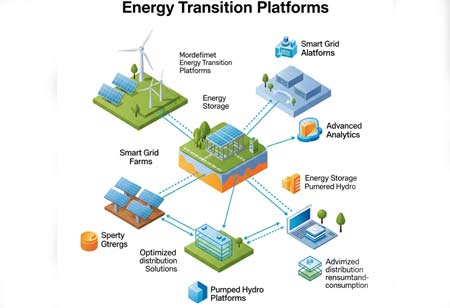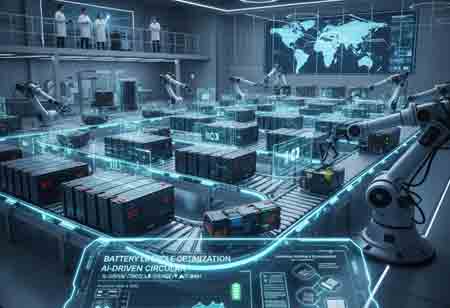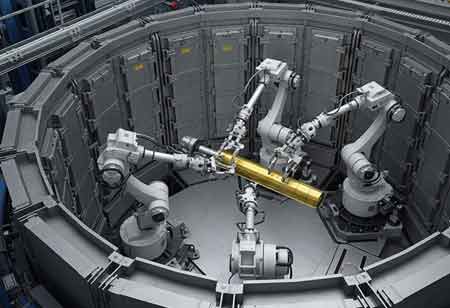CLOSE
Specials
I agree We use cookies on this website to enhance your user experience. By clicking any link on this page you are giving your consent for us to set cookies. More info
Be first to read the latest tech news, Industry Leader's Insights, and CIO interviews of medium and large enterprises exclusively from Energy Tech Review
Thank you for Subscribing
Strategic Investments in Clean Energy: Latin America's Role in the Global Transition
Latin America has the potential to lead the energy transition, driven by the development of sustainable energy sources.

By
Energy Tech Review | Friday, June 13, 2025
Stay ahead of the industry with exclusive feature stories on the top companies, expert insights and the latest news delivered straight to your inbox. Subscribe today.
Latin America is uniquely positioned to lead a robust energy transition by strategically leveraging its abundant solar, wind, and hydropower resources. This shift, characterized by significant investments, technological advancements, and evolving regulatory frameworks, is paving the way for a comprehensive and forward-looking energy landscape.
Current Landscape and Investment Dynamics
Latin America's energy mix, with its historical reliance on hydropower, has traditionally been cleaner than the global average. Renewables currently account for a substantial portion of the region's electricity generation, approximately 60 percent, which is double the world average. This strong foundation positions the region favorably for further decarbonization.
Investment in clean energy across Latin America has shown remarkable growth, increasing by nearly 25 percent over the past decade, reaching an estimated $70 billion. This surge is predominantly driven by wind and solar power, which have seen an average annual investment increase of 84 percent. Distributed energy systems, particularly small-scale solar photovoltaic (PV) installations, have played a significant role in this expansion, transforming energy consumers into producers and fostering decentralized generation.
Looking at individual country contributions, it's clear that certain nations in Latin America are leading the charge towards sustainable energy. Brazil, for instance, is a dominant force, consistently adding gigawatts of solar capacity each month and demonstrating a strong commitment to renewables through its energy expansion plans. Its enabling environment for small-scale solar PV and bioenergy has accelerated investment, particularly with the enactment of progressive legislation aimed at fostering future fuels. Chile has also made substantial strides, with wind and solar providing a third of its power, the largest share in the region. The country is also becoming a hub for energy storage, integrating battery assets with renewable projects to mitigate transmission constraints. Colombia and Costa Rica have also seen significant increases in renewable energy investment, with Costa Rica notably achieving nearly 98 percent of its electricity generation from renewable sources.
Technological Progress and Innovation
Beyond conventional wind and solar, the region is exploring and investing in cutting-edge technologies. Energy storage solutions, particularly lithium-ion batteries, are gaining prominence as they enable the greater integration of intermittent renewable energy sources and enhance grid reliability. Countries with significant lithium reserves are strategically leveraging these resources to develop domestic battery production capabilities, moving up the value chain in the clean energy supply chain.
Green hydrogen is emerging as another promising avenue, with several Latin American nations developing production and export hubs. Pilot projects are underway, positioning the region as a potential global supplier of this clean fuel. Offshore wind energy is also on the rise, with regulatory frameworks being established to encourage the deployment of wind farms that capitalize on coastal wind resources. The increasing demand for critical minerals essential for clean energy technologies, such as copper and lithium, positions Latin America as a vital player in the global supply chain, with efforts to expand production and processing capabilities.
Evolving Regulatory Frameworks
Robust and adaptive regulatory frameworks are fundamental to fostering a successful energy transition. Governments across Latin America are actively reviewing and implementing policies to create a supportive environment for renewable energy development and investment. A key focus is on increasing the share of non-conventional renewable energy in the electricity matrix and improving transmission systems to connect remote renewable sources to urban and industrial centers.
Many countries have developed regulations for both decentralized on-grid and off-grid energy generation, providing clarity and incentives for various project scales. Collaborative efforts among Latin American nations are also intensifying, with projects aimed at electrical interconnection to optimize resource utilization and ensure greater energy supply stability across borders. Initiatives to harmonize regulations are underway to attract broader regional investments.
Recent legislative developments reflect this commitment. Progressive laws aimed at promoting sustainable mobility and fostering the development of biofuels are being enacted, signaling a long-term vision for decarbonization that extends beyond the electricity sector. There is also a growing emphasis on creating transparent and predictable regulatory environments that provide long-term stability for investors. Discussions within regional energy regulatory bodies are focusing on topics such as service flexibility, energy security, and integrating non-conventional renewable energies, indicating a proactive approach to addressing the evolving needs of the energy sector. Furthermore, there is a recognized need to address regulatory gaps and ensure financial sustainability for energy projects, especially those aimed at expanding access in rural or underserved areas. Policies are being explored to define appropriate financing schemes and compensation methods, such as net-metering or feed-in tariffs, to ensure widespread adoption and equitable benefits.
Latin America's energy transition platform is on a trajectory of sustained growth and deepening integration. The region's leadership in clean energy is poised to continue, with projections indicating a substantial increase in renewable energy installed capacity. By 2050, a considerable portion of the electricity generation, potentially reaching 85 percent, is anticipated to come from clean sources. This ambitious goal will necessitate a substantial increase in renewable energy installed capacity.
The future will likely see further diversification of the energy mix, with continued expansion of solar, wind, and hydropower, complemented by emerging technologies such as green hydrogen and offshore wind. Investment in transmission infrastructure is expected to accelerate, ensuring that clean energy generated can reach demand centers efficiently. Efforts to reduce the cost of capital and attract a greater share of global private investment will be critical to achieving long-term decarbonization targets.
The ongoing focus on regulatory stability and the development of clear, long-term policy signals will be crucial for maintaining investor confidence and driving continued growth. Regional cooperation and the integration of energy markets are expected to strengthen, fostering a more resilient and interconnected energy system across Latin America. The emphasis on technological innovation, coupled with supportive policy frameworks, positions the region to not only meet its energy demands sustainably but also make a significant contribution to the global clean energy transition.

Copyright © 2025 Energy Tech Review. All rights reserved






